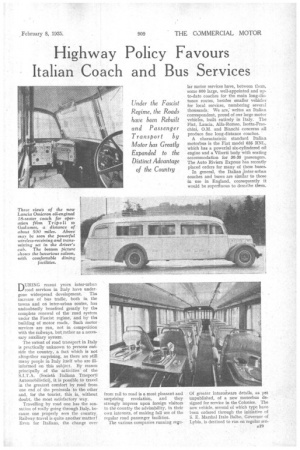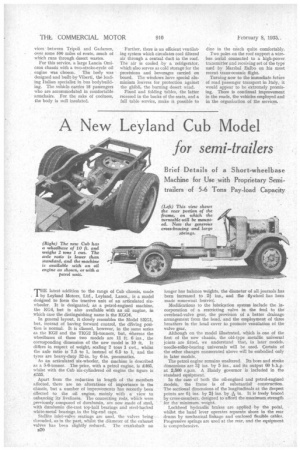Highway Policy Favours Italian Coach and Bus Services
Page 129

Page 130

If you've noticed an error in this article please click here to report it so we can fix it.
DURING recent years inter-urban road services in Italy have undergone widespread development. The increase of bus traffic, both in the towns and on inter-urban routes, has undoubtedly benefited greatly by the complete renewal of the road system under the Fascist regime, and by the building of motor roads. Such motor services are run, not in competition with the railways, but rather as a necessary auxiliary system.
The extent of road transport in Italy is practically unknown to persons outside the country, a fact which is not altogether surprising, as there are still many people in Italy itself who are illinformed on this subject. By reason principally of the activities of the S.I.T.A. (Societe. Italiana Trasporli Automobilistici), it is possible to travel in the greatest comfort by road . from one end of the peninsula . to the other and, for the tourist, this is, without doubt, the most satisfactory way.
Travelling by road one has the sensation of really going through Italy, because one properly sees the country. Railway-travel is quite another matter Even for Italians, the change over
from rail to road is a most pleasant and surprising revelation, and they strongly impress upon foreign visitors to the country the advisability, in their own interests, of making full use of the regular road passenger facilities.
The various companies running regu
lar motor services have, between them, some 600 large, well-appointed and upto-date coaches for the main long-distance routes, besides smaller vehicles for local services, numbering several thousands. We are; writes an Italian correspondent, proud of our large motor vehicles, built entirely in Italy. The Fiat, Lancia, Alfa-Romeo, Isotta-Fraschini, 0.M. and Bianchi concerns all produce fine long-distance coaches.
A characteristic standard Italian motorbus is the Fiat model 635 RNL, which has a powerful six-cylindered oil engine and a Viberti body with seating accommodation for 30-35 passengers. The Auto Riviera Express has recently placed orders for many of these buses.
In general, the Italian ;inter-urban coaches and buses are similar to those in use in England, consequently it would be superfluous to describe them.
Of greater interesatilare details, as yet unpublished, of a new motorbus designed for service in the Colonies. The new, vehicle, several of which type have been ordered through the initiative of S. E. Marshal Italo Balbo, Governor of Lybia, is destined to run on regular ser
vices between Tripoli and Gadames, over some 500 miles of route, much of which runs through desert wastes.
For this service, a large Lancia Omicron chassis with a two-stroke-cycle oil engine was chosen. The body was designed and built by Viberti, the leading Italian specialist in bus bodybuilding. The vehicle carries 18 passengers who are accommodated in comfortable armchairs. For the sake of coolness, the body is well insulated.
Further, there is an efficient ventilating system which circulates cool filtered air through a central duct in the roof. The air is cooled by a refrigerator, which also serves as cold storage for the provisions and beverages carded on board. The windows have special aluminium louvres for protection against the ghibli, the burning desert wind.
Fixed and folding tables, the latter recessed in the backs of the seats, and a full table service, make it possible to dine in the coach quite comfortably.
Two poles on the roof support a wireless aerial connected to a high-power transmitter and receiving set of the type used by Marshal Balbo on his most recent trans-oceanic flight.
Turning now to the immediate future of road passenger transport in Italy, it would appear to be extremely promising. There is continual improvement in the roads, the vehicles employed and in the organization of the services.














































































































































































